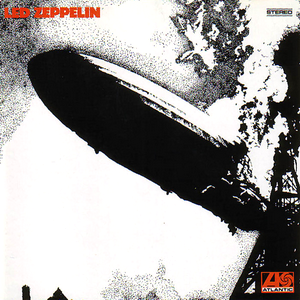When Led Zeppelin I dropped on January 12, 1969, it didn’t just introduce a new band—it heralded a seismic shift in rock music. This wasn’t merely another blues-influenced rock record; it was an unfiltered, electrified force that fused heavy guitar riffs, thunderous drumming, and primal wails into something both familiar and radical. The album marked the debut of a group that would go on to redefine rock, but from the very first note, Led Zeppelin I already felt fully formed—a masterful collision of blues, psychedelia, and what would soon be called heavy metal.
At the time, Led Zeppelin was an unknown entity, albeit with some familiar faces. Guitarist Jimmy Page had already made a name for himself as a session musician and as a member of The Yardbirds. When that band dissolved, Page recruited Robert Plant, John Paul Jones, and John Bonham to form a new group. What was initially called “The New Yardbirds” quickly morphed into something much bigger. Their self-titled debut, recorded in just 36 hours, was a declaration of intent—loud, unapologetic, and completely their own.
Sonic Exploration

From its opening notes, Led Zeppelin I presents itself as an album that thrives on raw energy and sonic boldness. Jimmy Page, who also served as the album’s producer, crafted a sound that was neither polished nor pristine—but that was precisely the point. Recorded in just 36 hours at Olympic Studios in London, the album captures the essence of a live performance, with a mix that feels urgent and unfiltered. Unlike the meticulously overdubbed studio albums of the era, Led Zeppelin I embraces space, reverb, and the natural dynamics of a band playing together in a room. The result is a record that feels alive, bursting with power and spontaneity.
Production Quality
While the album’s production isn’t necessarily lo-fi, it has a raw, unvarnished quality that sets it apart from many of its contemporaries. Jimmy Page was a pioneer in using room ambiance and natural reverb, which is particularly evident in John Bonham’s iconic drum sound. Instead of close-miking the kit—a standard practice at the time—Page positioned microphones at a distance, allowing the drums to breathe and resonate. This technique, revolutionary in 1969, became a defining characteristic of Zeppelin’s sound and influenced countless rock and metal records that followed.
The mixing also favors clarity and depth, giving each instrument its own space while maintaining a sense of cohesion. The guitars are thick and aggressive, the bass is deep and punchy, and Robert Plant’s vocals soar without being buried under excessive reverb or effects. Even with its unrefined edge, the album never sounds muddy or chaotic—every element is distinct yet interconnected, a testament to Page’s keen ear for sonic balance.
Musical Arrangements
One of Led Zeppelin I’s greatest strengths lies in its dynamic arrangements. The album moves seamlessly between blistering hard rock, slow-burning blues, and delicate acoustic passages, often within the same song.
- “Good Times Bad Times” sets the tone with its explosive intro and complex drum fills from John Bonham, whose triplet kick drum pattern was groundbreaking for rock drumming.
- “Dazed and Confused” builds from an eerie bass-driven verse into a full-throttle, psychedelic breakdown, complete with Page’s now-famous bowed guitar solo.
- “Your Time Is Gonna Come” surprises with a church-like organ introduction from John Paul Jones, before shifting into a folk-infused rock anthem.
- “Black Mountain Side” showcases Page’s intricate acoustic fingerpicking, heavily influenced by British folk guitarist Bert Jansch.
This versatility in arrangement makes Led Zeppelin I more than just a heavy blues-rock album—it’s a musical journey with unexpected twists and turns, constantly playing with tension and release.
Genre Elements
While firmly rooted in blues and rock, Led Zeppelin I pulls from a diverse palette of influences, laying the foundation for multiple subgenres.
- Blues Rock: Tracks like “You Shook Me” and “I Can’t Quit You Baby” pay direct homage to Chicago blues legends, with slow, simmering grooves and emotive guitar solos.
- Hard Rock: Songs like “Communication Breakdown” deliver fast, aggressive riffs that prefigure the energy of punk and heavy metal.
- Psychedelia: “Dazed and Confused” leans into dark, swirling textures, drenched in echo and effects, mirroring the experimental spirit of the late ‘60s.
- Folk & Eastern Influences: “Black Mountain Side” nods to Indian classical music, with its droning, modal structure and tabla accompaniment.
This seamless blending of styles was groundbreaking in 1969. Where other bands leaned into a single genre, Zeppelin refused to be confined, creating a sonic blueprint that countless artists would later build upon.
Lyrical Analysis

While Led Zeppelin I is often praised for its sonic innovation and instrumental mastery, its lyrics play a crucial role in shaping the album’s identity. At its core, the record draws heavily from blues traditions, with themes of love, loss, betrayal, and longing. Yet, Led Zeppelin also injects a sense of mysticism and psychological depth into their storytelling, hinting at the lyrical complexity that would become more pronounced in later albums.
Themes and Messages
Much of the album’s lyrical content is rooted in classic blues themes—unrequited love, heartache, and revenge. Songs like “You Shook Me” and “I Can’t Quit You Baby” are direct adaptations of Chicago blues lyrics, brimming with raw desire and emotional torment. These tracks reflect Zeppelin’s deep reverence for the blues, though Robert Plant’s delivery and the band’s explosive instrumentation elevate them into something grander and more ferocious.
However, the album also introduces themes that go beyond traditional blues narratives. “Dazed and Confused” is perhaps the most lyrically intriguing track on the album. Though originally written by folk singer Jake Holmes, Zeppelin’s version transforms it into a sinister tale of paranoia and emotional devastation. Lines like:
“Been dazed and confused for so long it’s not true / Wanted a woman, never bargained for you”
evoke a sense of betrayal and psychological unraveling, heightened by Plant’s haunting wails and the song’s dramatic, stop-start structure. The ambiguity of the lyrics leaves room for multiple interpretations—some see it as a love-gone-wrong story, while others view it as a broader reflection on disillusionment.
Another outlier is “Your Time Is Gonna Come,” which takes the perspective of someone who has been wronged in love but sings with defiant confidence about karmic justice. The lyrics’ simplicity makes them instantly relatable, turning heartbreak into empowerment.
Lyrical Depth
Most of Led Zeppelin I’s lyrics are relatively direct, a reflection of the band’s blues influences. They focus on personal emotions—desire, regret, longing—rather than abstract poetry or grand storytelling. Unlike later Zeppelin albums, which would delve into Tolkien-esque fantasy and mythological allegories, this debut keeps its feet firmly planted in blues realism.
However, there are moments of deeper lyrical intrigue. “Dazed and Confused” and “How Many More Times” introduce a dreamlike, almost hallucinatory quality, where emotions blur into surreal imagery. The latter track, for instance, plays with classic blues tropes but stretches them into something wilder:
“I was a young man, I couldn’t resist / Started thinkin’ it over, just what I had missed”
This line starts as a conventional blues lament but, as the song progresses, the storytelling becomes increasingly frantic and abstract, culminating in the hypnotic repetition of the title phrase, reinforcing a sense of obsession and desperation.
Emotional Impact
The emotional weight of Led Zeppelin I comes less from its lyrical complexity and more from the sheer intensity of its delivery. Robert Plant, still in his early twenties, delivers every line with unfiltered passion, whether it’s the lustful growl of “You Shook Me” or the aching vulnerability in “Babe I’m Gonna Leave You.” Even when the lyrics are simple, Plant’s voice imbues them with an undeniable emotional pull.
Beyond the vocals, the instrumental arrangements amplify the lyrics’ emotional resonance. In “Babe I’m Gonna Leave You,” the quiet-loud dynamics mirror the internal turmoil of a painful goodbye, making the heartbreak feel even more visceral. In “Dazed and Confused,” the ominous bassline and wailing guitar bends turn Plant’s paranoia-infused lyrics into something nightmarish.
Cohesion and Flow

For a debut album recorded in just 36 hours, Led Zeppelin I demonstrates remarkable cohesion. Though the record jumps between electrified blues, psychedelic experimentation, and delicate acoustic passages, it never feels disjointed. Instead, it unfolds like a raw, unfiltered statement of intent—an album that captures the band’s live energy while laying the groundwork for their future sonic explorations.
Track Progression
From the moment “Good Times Bad Times” kicks off with its driving riff and Bonham’s machine-gun drum fills, the album asserts itself as a high-energy force. It’s a fitting opener—concise, punchy, and a perfect introduction to Zeppelin’s signature blend of blues power and rock innovation.
The album then takes a sharp turn into “Babe I’m Gonna Leave You,” an emotionally charged folk-blues ballad that builds from delicate acoustic picking to an explosive, gut-wrenching climax. This early shift showcases Zeppelin’s dynamic range and sets the precedent for how the album will oscillate between hard-hitting rockers and more introspective moments.
The transitions between songs are effective in maintaining engagement. “You Shook Me” follows, a slow-burning blues cover drenched in heavy guitar licks and wailing vocal exchanges between Plant and Page’s slide guitar. The tempo slows, but the tension remains high, giving the listener a moment to sink into Zeppelin’s take on the blues before plunging into “Dazed and Confused.”
The latter half of the album continues this ebb and flow:
- “Your Time Is Gonna Come” offers a moment of respite, with John Paul Jones’s sweeping organ intro setting a grand yet soothing tone before shifting into a singalong-friendly melody.
- “Black Mountain Side” acts almost like a palette cleanser, a brief, hypnotic acoustic interlude that prepares the listener for the hard-hitting final stretch.
- “Communication Breakdown” reignites the energy with its proto-punk intensity, followed by the winding, bluesy journey of “I Can’t Quit You Baby.”
- Finally, “How Many More Times” closes the album on an epic, meandering note, blending storytelling, improvisational jams, and thunderous crescendos into a fitting grand finale.
The sequencing of the album is not just about individual song quality—it’s about contrast. The interplay between loud and soft, fast and slow, structured and improvisational, keeps the listener engaged. There’s no strict narrative arc, but the emotional peaks and valleys create a sense of movement that makes Led Zeppelin I feel like a journey rather than just a collection of songs.
Thematic Consistency
Despite its stylistic diversity, Led Zeppelin I maintains a strong thematic and sonic identity. The throughline connecting all the tracks is the band’s deep-rooted love for the blues, reinterpreted through their own electrified, high-intensity lens. Even in its quieter moments, the album never loses its underlying tension—whether it’s the melancholic longing of “Babe I’m Gonna Leave You” or the ominous dread of “Dazed and Confused.”
Another unifying factor is the sheer urgency in the performances. There’s an almost reckless abandon to the way the songs unfold, as if the band is pouring everything they have into each track. This raw energy, coupled with the album’s live-style production, makes it feel cohesive despite the stylistic shifts.
That said, some critics at the time viewed the blend of genres as uneven or unfocused. The inclusion of folk instrumentals alongside heavy blues jams was unusual for 1969, and the album’s willingness to switch gears so drastically may have felt jarring to some listeners. However, in retrospect, this unpredictability is part of what makes Led Zeppelin I so compelling. Instead of adhering to a single formula, it embraces a broader spectrum of rock and blues influences, setting the stage for Zeppelin’s genre-defying career.
Standout Tracks and Moments
Every song on Led Zeppelin I contributes to its legendary status, but a few key tracks and moments stand out as definitive showcases of the band’s power, innovation, and emotional depth. Whether through electrifying guitar work, dynamic shifts, or Robert Plant’s spine-tingling vocals, these highlights capture the essence of what made Led Zeppelin a force to be reckoned with.
Standout Tracks
“Dazed and Confused”
Arguably the most haunting and experimental track on the album, “Dazed and Confused” is a six-minute descent into paranoia and despair. John Paul Jones’ sinister descending bassline sets the stage, while Jimmy Page’s eerie bowed guitar solo creates a swirling, otherworldly atmosphere. Robert Plant’s tortured wails and dynamic shifts—from quiet eeriness to full-blown rock chaos—make this a cornerstone of Zeppelin’s early sound. The song’s ability to stretch and evolve in live performances would cement it as a Zeppelin classic.
“Good Times Bad Times”
A flawless album opener, “Good Times Bad Times” immediately establishes Led Zeppelin’s sonic trademarks. Bonham’s innovative bass drum triplets (played with a single foot) were groundbreaking, showcasing a level of technical prowess rarely heard in rock drumming at the time. The tight interplay between Page’s sharp riffs and Jones’ pulsating bass keeps the song driving forward, while Plant’s confident, soaring vocals make it clear that Zeppelin had arrived with something to prove.
“Babe I’m Gonna Leave You”
This folk-blues ballad is a masterclass in dynamics. Beginning with delicate acoustic fingerpicking, the song gradually builds in intensity until it erupts into one of Plant’s most impassioned vocal performances. The contrast between the quiet verses and the thunderous choruses creates a dramatic push-and-pull effect, showcasing Zeppelin’s ability to harness emotional depth through instrumentation.
Memorable Moments
Jimmy Page’s Bowed Guitar on “Dazed and Confused”
One of the most mesmerizing moments on the album is Page’s use of a violin bow on his guitar in “Dazed and Confused.” The eerie, wailing sounds add an almost supernatural element to the song, reinforcing its dark, menacing tone. This technique would become a signature part of Zeppelin’s live performances.
John Bonham’s Drum Work on “Good Times Bad Times”
From the very first track, Bonham announces himself as one of rock’s most formidable drummers. His rapid-fire triplet kick drum pattern in “Good Times Bad Times” remains one of the most technically impressive and influential drum parts in rock history.
Robert Plant’s Wailing High Notes in “Babe I’m Gonna Leave You”
Few vocal moments capture the raw emotion of Led Zeppelin I quite like Plant’s high-pitched wails in “Babe I’m Gonna Leave You.” His voice cracks with intensity as he belts out “Babe… BABE! BABE! I’m gonna leave you!”—a moment that feels almost painfully real, as if he’s physically torn by the decision.
The Psychedelic Breakdown in “How Many More Times”
Midway through the album’s final track, the music takes a sharp turn into a hallucinatory, freeform jam. The groove slows, Plant’s vocals become more hypnotic, and Page’s guitar drifts into a trance-like state. This unpredictable moment encapsulates Zeppelin’s willingness to break conventional song structures and explore new sonic territory.
Artistic Contribution and Innovation

From the moment Led Zeppelin I hit turntables in early 1969, it was clear that this wasn’t just another blues-rock album—it was a seismic shift in the genre. At a time when psychedelic rock was still in full swing and blues-based rock bands like Cream and The Jimi Hendrix Experience were dominating the scene, Led Zeppelin took things a step further. The album was louder, heavier, more dynamic, and more ambitious than anything else at the time. While it was rooted in the blues, it reimagined those traditions in a way that would directly shape the future of hard rock and heavy metal.
Place in Genre/Industry
Before Led Zeppelin I, rock music was experiencing a transition. The British blues boom, spearheaded by bands like The Yardbirds, Fleetwood Mac (in their early, blues-driven form), and John Mayall & the Bluesbreakers, was thriving. Meanwhile, psychedelic rock was evolving into something heavier and more experimental. Led Zeppelin entered this landscape not as imitators, but as innovators—melding blues, folk, and rock with an intensity and heaviness that had never been heard before.
While some critics at the time dismissed the album as too derivative of American blues, it was actually doing something revolutionary. Instead of simply covering blues standards in a traditional format, Zeppelin infused them with bombastic drumming, high-octane riffing, and dynamic shifts that made the songs feel urgent and unpredictable. This wasn’t blues-rock in the vein of The Rolling Stones; it was something rawer, darker, and more aggressive.
The album’s commercial success also marked a turning point for the music industry. At a time when singles still largely dictated success, Led Zeppelin ignored conventional wisdom by releasing Led Zeppelin I without a lead single. The record became a massive success purely on the strength of album sales and word-of-mouth. This approach, which prioritized the album as an artistic statement rather than a vehicle for hit singles, would become a defining characteristic of rock music in the 1970s.
Innovation
Though Led Zeppelin I wasn’t the first heavy album, it was the one that codified what would later be called hard rock and heavy metal. Its innovations spanned multiple areas:
Production Techniques: The Birth of the “Big Sound”
Jimmy Page’s approach to production was groundbreaking. Instead of the dry, close-miked recordings that dominated rock at the time, Page used distance miking and natural room reverb to create a sense of space and depth. This is particularly noticeable in John Bonham’s drumming, which has a massive, almost three-dimensional quality. This technique became a staple of rock and metal production, influencing everyone from Queen to Metallica.
The Riff-Driven Sound
While blues-rock had always incorporated riffs, Zeppelin took the concept to new heights. Songs like “Good Times Bad Times” and “Communication Breakdown” featured tight, aggressive, and instantly recognizable riffs that would lay the groundwork for hard rock’s guitar-driven ethos. The chugging downstrokes in “Communication Breakdown,” in particular, prefigure the sound of punk and metal.
Vocal Power and Theatricality
Robert Plant’s soaring, almost operatic vocal delivery was unlike anything in rock at the time. While singers like Roger Daltrey (The Who) and Steve Marriott (Small Faces) had powerful voices, Plant brought a sense of unrestrained passion and high-pitched wails that would become the gold standard for hard rock and metal vocalists. His performances on “Dazed and Confused” and “Babe I’m Gonna Leave You” added an emotional intensity that went beyond traditional blues-rock.
John Bonham’s Drumming: A Game-Changer
Bonham’s drumming wasn’t just about power—it was about groove, precision, and innovation. His use of rapid-fire bass drum patterns (as heard in “Good Times Bad Times”) was groundbreaking, and his ability to swing, even in the heaviest moments, made Zeppelin’s music feel organic and dynamic. His influence can be heard in nearly every hard rock and metal drummer that followed, from Neil Peart (Rush) to Dave Grohl (Nirvana, Foo Fighters).
Fusion of Genres: Blues, Folk, and the Birth of Zeppelin’s Signature Sound
Unlike their peers, Zeppelin wasn’t afraid to mix seemingly disparate styles. “Black Mountain Side” incorporated Eastern influences, “Babe I’m Gonna Leave You” balanced folk delicacy with rock bombast, and “Dazed and Confused” blended psychedelic eeriness with raw blues aggression. This genre-hopping approach became a defining characteristic of their sound, culminating in even more ambitious works on later albums.
Closing Thoughts

Few debut albums have had the seismic impact of Led Zeppelin I. From its electrifying opening riff to its final, sprawling jam, the album is a bold statement of intent—one that would lay the foundation for not just Led Zeppelin’s legendary career, but for the evolution of hard rock and heavy metal itself. The sheer confidence and raw power of this record make it one of the most important releases in rock history.
Strengths
Groundbreaking Sound: The fusion of blues, folk, and psychedelic rock into something heavier and more intense set a new precedent for rock music.
Unmatched Musicianship: Every member of the band delivers career-defining performances—Page’s guitar work is inventive, Bonham’s drumming is thunderous, Jones’ bass and keys add essential depth, and Plant’s vocals are nothing short of revelatory.
Innovative Production: Jimmy Page’s pioneering production techniques created a sense of space and power that would influence generations of musicians and producers.
Diversity and Dynamics: The album seamlessly shifts between acoustic delicacy and full-throttle rock fury, keeping listeners engaged from start to finish.
Weaknesses
Derivative Elements: Critics at the time accused Zeppelin of lifting too heavily from blues legends without proper credit, an issue that followed them throughout their career. However, their reinterpretation of these influences was so transformative that the album still feels fresh and original.
Rough Edges: The rawness of the production and the improvisational feel of some tracks might not appeal to listeners who prefer polished, meticulously structured compositions. But this rawness is also part of its charm.
Official Rating: 10/10
Giving Led Zeppelin I anything less than a 10/10 would be doing a disservice to its legacy. While later Zeppelin albums may have been more refined or ambitious, this debut remains one of the most explosive and influential records of all time. It captures the band at their most primal and hungry, delivering a sound that would inspire countless artists across multiple genres.
